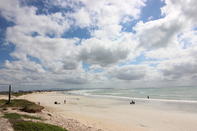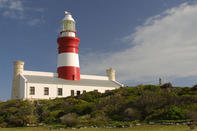Magnificent Sweeps of Sand
The area immediately to the west of L’Agulhas is little known and seldom visited. Some is private land, the rest is a loose patchwork comprising parts of Agulhas National Park. It is a wild, intoxicating stretch of coast with whale-filled bays, rocky promontories.

There are magnificent sweeps of sand, such as Jessie’s Bay, headlands like Quoin Point studded with shipwrecks, old Cape Dutch holiday ‘estates’ such as beautiful Brandfontein snug in the shadow of Soetanysberg. Khoisan fish traps and shell middens near Die Walle and the pioneer-stock-farmer dwelling of Renosterkop, dating from the 18th century and badly in need of restoration.
L'Agulhas Lighthouse

L’Agulhas does have one gem: the Lighthouse. Within the 30-mile range of Agulhas Lighthouse the coast is fringed with reefs on which more ships have been wrecked than on any other part of the South African coast. The following plea from a farmer in the district was put on record: ‘I have been painfully called upon to witness ship after ship cast away, valuable cargoes strewed along the beach, and hundreds of human beings at a time washed up dead upon the shore. There was the Arniston on 30 May 1815, a total wreck with no less than 372 bodies of men, women and children washed up. Had a lighthouse been near, this incident would probably not have happened.’
The limestone structure was duly completed in 1849, built in the style of the Pharos in Alexandria, one of the seven wonders of the ancient world. Today Agulhas is part working light, part museum, part Foot of Africa Coffee Shoppe. There are old charts and keepers’ uniforms preserved down the generations, and a large driebeenpotjie used to boil sheeps’ tails to produce fat for fuelling the lamp.
By Justin Fox The seaside beauty of Cape Agulhas and Struis Bay (or Struisbaai) can be experienced in many ways. This corner of South Africa is known for ...
The seaside beauty of Cape Agulhas and Struis Bay (or Struisbaai) can be experienced in many ways. This corner of South Africa is known for ... Cape Agulhas is the southernmost point of Africa, and the official meeting point of the cold Atlantic and warm Indian Oceans. Also known as ...
Cape Agulhas is the southernmost point of Africa, and the official meeting point of the cold Atlantic and warm Indian Oceans. Also known as ...